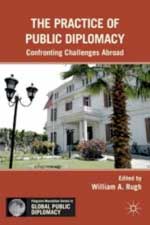 Review by William P. Kiehl, Ed.D., Editor of American Diplomacy
Review by William P. Kiehl, Ed.D., Editor of American Diplomacy
The Practice of Public Diplomacy: Confronting Challenges Abroad, Edited by William A. Rugh, New York: Palgrave Macmillan, March 2011, ISBN: 978-0-230-11322-0, 280 pp., $85
“This book shows great promise” was an initial reaction while reading the superb introduction to this volume by editor Ambassador (ret.) William Rugh. Dr. Rugh put this collection of 14 essays together from term papers submitted by his graduate school students at the Fletcher School of Law and Diplomacy at Tufts University. The “promise” was anticipation that the volume under review would fill a void in the relatively new academic field of public diplomacy studies. That gap consists of narrative material focusing on the practical work of public diplomacy officers at overseas posts. The need is, as the editor states, “to convey an understanding of public diplomacy as it is practiced by professionals at American embassies abroad.” Calling, in essence, for case studies in U. S. public diplomacy.
Alas the promise is only partially fulfilled here. The book has all of the advantages of academic writings by enthusiastic young scholars but also many of its drawbacks. This reviewer was eager to read case studies but found really only a scant number of them were worthy of special attention. Among the instructive ones were descriptions of contemporary public diplomacy work in Serbia, Turkey, Afghanistan and Pakistan. More historical than practical but nonetheless elucidating was Elise Crane’s chapter on public diplomacy efforts in the former Soviet Union, then Russia. (Readers may recall that a portion of this chapter focusing on Amerika magazine appeared in a slightly different form in this journal some months ago.) Other writings, however — while of graduate school quality — were rather off the mark. Comparisons of public diplomacy broadcasting to Iran and public diplomacy work in London seem a rather odd juxtaposition. There was much ado about very little regarding social media efforts in Africa, Asia and elsewhere. The final section on “New Thinking about Public Diplomacy”, with the exception of Dr. Rugh’s conclusions, seems to have been included to broaden the book’s scope beyond its original intentions.
Most of the authors have spent considerable time living or working abroad, including in some cases as interns or employees in public diplomacy offices abroad. The individual essays are quite well researched, relying on secondary sources for the most part but also including interviews, either in person, by phone or e-mail, with State Department working level officials and with public diplomacy officers in the field, past and present. The interview material adds immediacy and a contemporary feel to the essays and in most cases constitutes the real substance of the case studies.
Some of these interview quotes leave the reader wondering what is really behind the statements. There is little light shed on public diplomacy practitioners’ agendas or intentions. For example, a Foreign Service officer in London seems to go out of his or her way to criticize for no evident reason a previous Ambassador for his lack of interest in public diplomacy. Or witness the repeated paeans of praise for President Obama, as though public diplomacy were overwhelmingly dependent on the international likeability of the chief executive rather than the coincidence of national interests and perceptions thereof.
While some of this can be chalked up to the exuberance of youth, it does leave the troubling impression that these young scholars may not have dug deeply enough beneath the surface of their case studies but merely accepted opinions as facts. There are some minor but irritating errors like the assertion that television was a major propaganda tool in World War II whereas, in fact, the medium was still largely experimental and did not come into its own until the post-war period.
Despite its flaws, the book breaks some ground in that it focuses on the overseas operations of public diplomacy rather than the “inside the Beltway” interagency policy formulation and organizational difficulties, which have taken up so much of the debate on post-USIA public diplomacy. It is a welcome intellectual development to see a book that puts the emphasis on how U. S. public diplomacy actually functions in the real world.![]()

William P. Kiehl, Ed. D. is the current editor of American Diplomacy. Following a 33 year Foreign Service career in public diplomacy in Europe and Asia, he founded the international public affairs consultancy PDWorldwide in 2003. His doctorate in Higher Education Management is from the University of Pennsylvania. He is the author of Global Intentions Local Results, editor of America’s Dialogue with the World and The Eagle and the Elephant: Thai-American Relations Since 1833 and has written a number of articles and book chapters on public diplomacy and international affairs.
